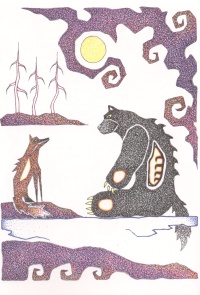| ________________
CM . . .
. Volume XII Number 16 . . . .April 14, 2006
excerpt:
The third book in the “Birchbark Series,” which includes How the Eagle Got His White Head and The Dreamcatcher Pool, is a beautiful tale that reverses the roles of the two main characters. Rather than the grandmother telling her young grandson Heyden one of the Algonquin myths, this time young Heyden has written down a myth as a present for his grandmother. This framing device is not only touching, but it also illustrates the importance of recording in written form the traditional tales. As well, the particular tale Heyden has recorded, how the bear lost his tail, is wonderful. Poor bear, whose tail was once beautiful, long and bushy, is tricked into using his tail as a fishing rod on an ice-covered lake. Bear waits and waits for a fish to bite, but none do. As he waits, ice forms around his tail, and so when the fox tells him to pull his tail out, it rips right off. Although it seems that fox is a horrible character, Heyden, at the end of the tale, explains that fox is not as bad as he might seem. Since fox is so much smaller than bear, he needs to have some tricks in order to get enough food. He is resourceful and crafty, explains Heyden. The trickster fox and the big-hearted bear are two character types that crop up in many myths around the world. The African trickster spider Anansi and big-hearted lion, for example, are parallel creatures. Many of British Columbia’s First Nations peoples’ legends concern the trickster raven. At the end of this book, Chartrand has even added small biographies of these two legendary characters.
The only major drawback of this book, however, is its format. Being staple-bound, with an odd length of pages, makes it difficult for classification. It is neither a picture book, nor first-reader, nor chapter book. It is too bad more tales weren’t put together in order to make it a chapter book of myths. That said, overall it is a great and important read which passes down a humorous Algonquin tale. Recommended. Kallie George is currently doing her Masters of Children’s Literature at the University of British Columbia in Vancouver, BC.
To comment
on this title or this review, send mail to cm@umanitoba.ca.
Copyright © the Manitoba Library Association. Reproduction for personal
use is permitted only if this copyright notice is maintained. Any
other reproduction is prohibited without permission.
NEXT REVIEW |
TABLE OF CONTENTS FOR THIS ISSUE
- April 14, 2006.
AUTHORS |
TITLES |
MEDIA REVIEWS |
PROFILES |
BACK ISSUES |
SEARCH |
CMARCHIVE |
HOME |

 Zaawaazit Mkwa Tsun’s illustrations done in mixed media (mostly pen) in a traditional Algonquin style are very interesting. Continuous squiggly lines that fill out characters give the effect of pointillism. Only a few colors are used, primarily muted blues, oranges and purples, white space is heavily employed, and so are jagged curly lines, all which add up to pictures that look similar to stamp art or wood-cuts, very beautiful but also distancing. Like the story, the art certainly could certainly promote much discussion.
Zaawaazit Mkwa Tsun’s illustrations done in mixed media (mostly pen) in a traditional Algonquin style are very interesting. Continuous squiggly lines that fill out characters give the effect of pointillism. Only a few colors are used, primarily muted blues, oranges and purples, white space is heavily employed, and so are jagged curly lines, all which add up to pictures that look similar to stamp art or wood-cuts, very beautiful but also distancing. Like the story, the art certainly could certainly promote much discussion.